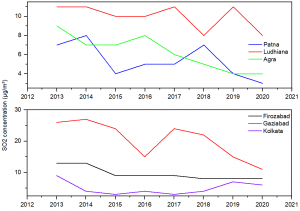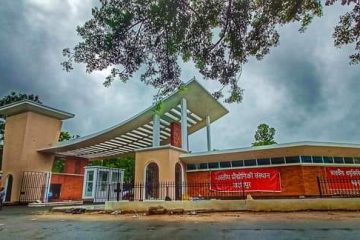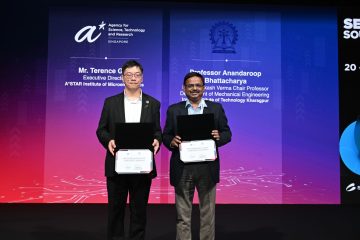FLUE GAS DESULPHURIZATION REDUCES SO2 POLLUTION IN INDIA
A study by a team of researchers from IIT Kharagpur led by Prof. Jayanarayanan Kuttippurath from Centre for Oceans, Rivers, Atmosphere and Land Sciences (CORAL) found a significant decline in SO2 trends in India in the last decade, as compared to those in the previous three decades. The decrease in trend and concentration of SO2 is due to the environmental regulation and adaptation of effective control technologies such as scrubber and Flue Gas Desulphurization that shows the positive impact of technological advance and policy decisions to improve the air quality in India. The study represents temporal changes in SO2 concentrations over India in the past four decades (1980–2020). Thermal power plants (51%), and manufacturing and construction industries (29%) are the main sources of anthropogenic SO2 in India. The temporal analyses reveal that SO2 concentrations in India increased between 1980 and 2010 due to high coal burning and lack of novel technology to contain the emissions during that period. Both economic growth and air pollution control can be performed hand-in-hand by adopting new technology to reduce SO2 and GHG emission.

Prof. Jayanarayanan Kuttippurath
Centre for Oceans, Rivers, Atmosphere and Land Sciences (CORAL)
IIT Kharagpur
“SO2 is an atmospheric pollutant and can be converted to sulfate aerosols in high humid conditions. These aerosols can affect cloud reflectively, rainfall and regional climate by modifying the radiative forcing. At high concentrations, SO2 affects adversely on human health and ecosystem as well. Therefore, continuous monitoring of its abundance in the atmosphere is highly warranted, as these kind of analyses would help making the policy decisions related to emissions. This particular study is serving that purpose,” remarked Jayanarayanan Kuttippurath, Centre for Oceans, Rivers, Atmosphere and Land Sciences (CORAL), IIT Kharagpur and the lead author of the study.
Sulphur dioxide (SO2) is one of the criteria pollutants that mainly released from the coal-based thermal power plants. At higher concentrations, it has hazardous affects on public health and environs. In this study, we find a significant decline in SO2 trends in India in the last decade, as compared to those in the previous three decades. The decrease in trend and concentration of SO2 is due to the environmental regulation and adaptation of effective control technologies such as Scrubber and Flue Gas Desulphurization showing the positive impact of technological advance and policy decisions to improve the air quality in India.
“Our analysis shows Indo-Gangetic Plain and Central and Eastern India regions as the SO2 hotspots in India. Although there is a relative reduction in SO2 in the last decade, the concentration of SO2 is still very high in these regions. Therefore, we need to continue our efforts to reduce SO2 emission in India, whether it is with innovative technology or environmental regulations,” said Vikas Kumar Patel, another author of the paper.
 Fig 1: The SO2 trends in the last four decades in India. A rapid economic development in the 2001-2010 periods shows the largest trends among the decades. However, the recent decades with technological advance and environment policies help to reduce atmospheric SO2 concentrations and its trends.
Fig 1: The SO2 trends in the last four decades in India. A rapid economic development in the 2001-2010 periods shows the largest trends among the decades. However, the recent decades with technological advance and environment policies help to reduce atmospheric SO2 concentrations and its trends.
An improved air quality monitoring network is needed to understand the spatial and temporal changes of pollutants, which would help to make policies relevant to improve air quality and to meet targeted reduction in emissions. The measurements and emissions in this study have uncertainities and are not computed in absolute figures. However, the trends computed are statistically significant across all Indian regions. Therefore, the findings have important implications for future environmental policies on India’s SO2 emissions and for understanding the impact of SO2 on regional climate, air quality, ecosystem dynamics, and public health. This study also provides a baseline for future studies that would critically examine changes in SO2 pollution as a result of the country’s socio-economic development.
“What we have found from our analysis is that, SO2 has been increasing in India for the past few decades, consistent with our economic development, but a declining trend in SO2 is found in the last decade (2010-2020). This is a good sign. The implementation of Bharat Stage norms on vehicular emissions, regulations for power plants to employ scrubber and FGD technologies, and policies encouraging the production of renewable energy may have contributed to this reduction in SO2 emissions,” added Prof. Kuttippurath.

Fig 2: Ground-based measurements also show reduction or stabilization of SO2 emissions; as shown for different cities here.
Due to rapid industrialization and urbanization in the past decades, India’s energy demand has been increased substantially with coal consumptions. The expansion of coal-based electricity generation in India is the primary cause of the country’s high emission. Although these help economic development of the country, the air pollution also increases along with it, which poses a health concern. Currently, India is one of the world largest emitters of SO2, accounting for more than 15% of global anthropogenic emissions. The situation warrants reduction SO2 emission in our country. However, majority of coal plants in India lack the Flue-Gas Desulfurization (FGD) technology necessary to adequately remove SO2 emissions. On the other hand, India’s power sector has seen an increase in renewable energy capacity, which would help to curb the pollution in India.
Prof. V K Tewari, Director, IIT Kharagpur stated, “India relies heavily on coal-based thermal power plants to meet its energy demands. Analysis of spatial and temporal changes in SO2 using accurate and continuous observations is required to formulate mitigation strategies to curb the increasing air pollution in India. Since 2010, India’s renewable energy production has also increased substantially when India adopted a sustainable development policy. The shift in energy production from conventional coal to renewable sources, solid environmental regulation, better inventory, and effective technology would help to curb SO2 pollution in India. India’s nationally determined contributions under the Paris Agreement includes achieving about 40% cumulative electric power installed capacity from non-fossil fuel-based energy resources by 2030. This commitment would help to reduce the dependency on the coal-based energy, and also help to curb the SO2 pollution in the future.”
Publication Links:
https://doi.org/10.1007/s11356-022-21319-2
Media Coverage:
| Economic Times | The Hindu | Business Standard |
| Deccan Herald | Financial Express | Telegraph |
| Jagran | The Print | Siasat |
| Khabar Dunya | The Hans India | Gulf Today |
| Mongabay |
Contact Person: Prof. Jayanarayanan Kuttippurath, Centre for Oceans, Rivers, Atmosphere and Land Sciences (CORAL)
Email: jayan@coral.iitkgp.ac.in
Edited by : Poulami Mondal, Digital & Creative Media Executive (Creative Writer)
Email: poulami.mondal@iitkgp.ac.in, media@iitkgp.ac.in, Ph. No.: +91-3222-282007
Follow us: Facebook – IIT Kharagpur; Twitter – @IITKgp; Instagram – @iit.kgp; LinkedIn – Indian Institute of Technology
For news visit: https://kgpchronicle.iitkgp.ac.in/



